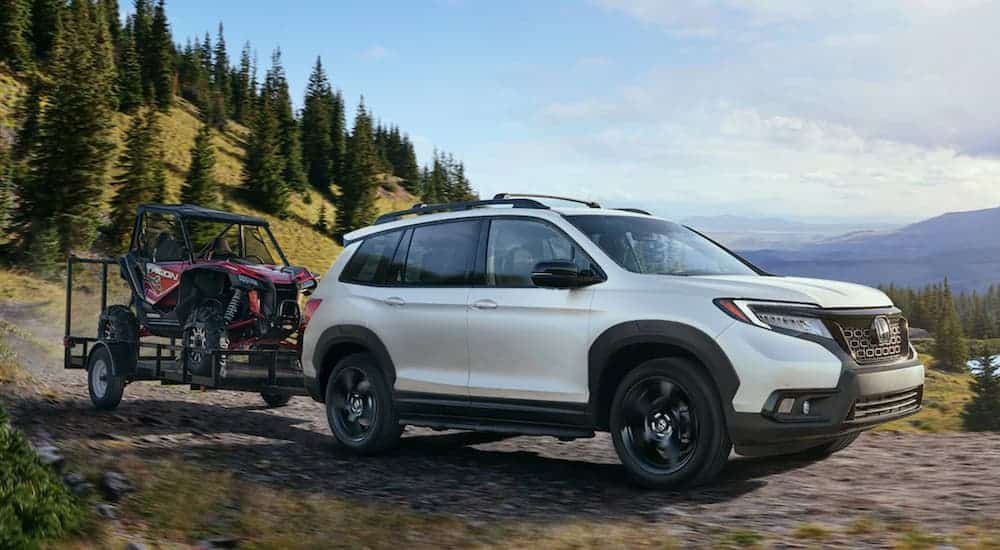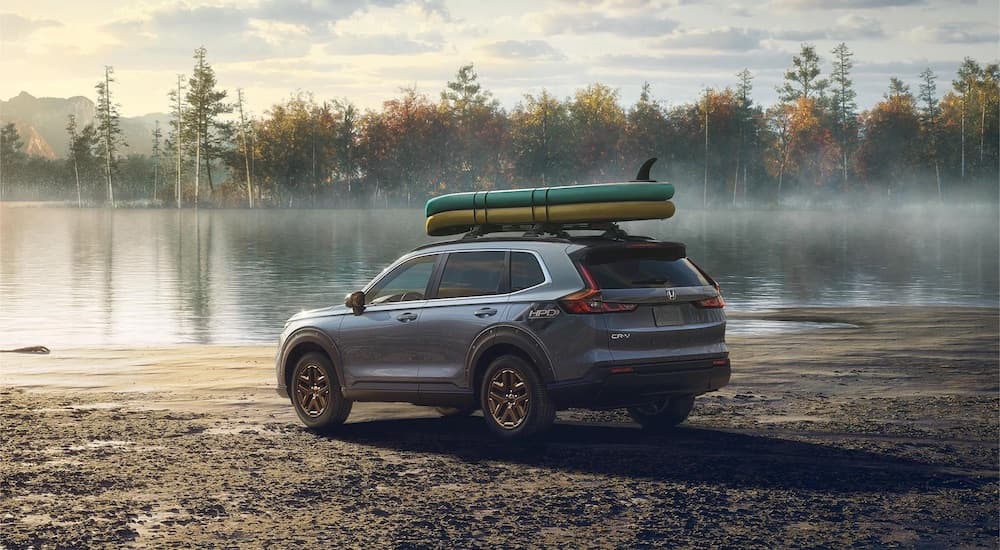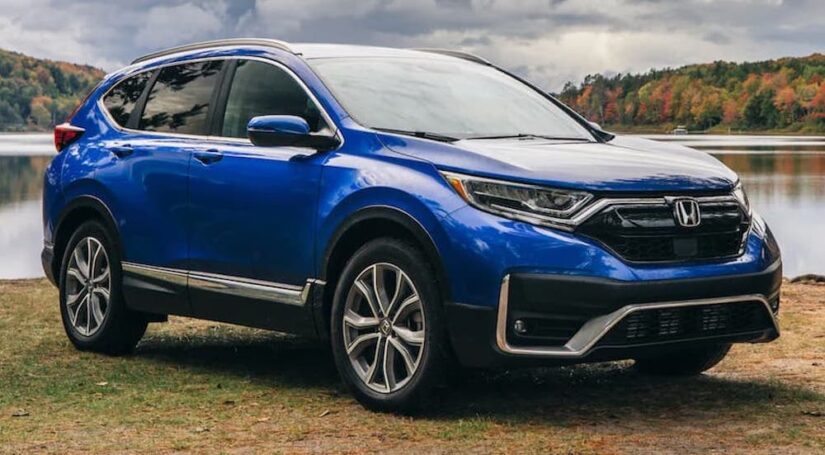SUVs are the largest segment of cars for sale across the country, with options stretching from subcompact and compact to midsize and full-size models. Yet, not all SUVs are the same. Some automakers do a far better job of building long-lasting, reliable models packed with value. Honda is at the top of that list, making two-row SUVs like their CR-V and Passport popular picks.
The CR-V and Passport share many similarities, from their two-row layouts to their infotainment systems and driver assistance tech. But what makes them different? Drivers looking for a two-row SUV can appreciate having two options in the Honda lineup, but how do you decide which model is right for you? Here’s a closer look at how the CR-V and Passport differ to kickstart your shopping spree…
#1. Size Classification
The Passport and CR-V have been staples in the Honda lineup since the 1990s, with the Passport taking a hiatus after the new millennium and returning to the family in 2019. Most notably, the CR-V made history in the late 1990s by introducing a new classification of SUVs. Honda’s Comfortable Runabout Vehicle was hard to classify because it handled like a sedan but boasted a larger cabin and a higher driving position like an SUV. The crossover segment was born, with the CR-V taking its place as Honda’s compact powerhouse.
As a compact SUV, the CR-V is smaller than the Passport, with its size enhancing its agility and maneuverability. The 2024 CR-V sits on a 106.3-inch wheelbase and measures 184.8 inches long—dimensions overshadowed by the Passport and its 110.9-inch wheelbase and 189.1-inch length. The CR-V is also shorter than its larger sibling, standing at 66.2 inches tall compared to the Passport’s 72.2-inch height. As a result, the CR-V is often easier to park and maneuver in congested areas or tight parking spaces.
#2. Cabin Capacities
The CR-V and Passport can both accommodate up to five people with their two-row layouts. As a midsize SUV, the Passport’s taller height and longer length lead many to assume its cabin is more spacious and passenger-friendly. However, comparing its dimensions with the CR-V tells another story.
The 2024 CR-V has a more spacious front row with 40 inches of headroom and 41.3 inches of legroom. In contrast, the Passport’s front row capacities include 39.5 inches of headroom and 40.9 inches of legroom, the latter of which makes the driver and passenger seats more cramped. The 2024 Passport gains a slight advantage in the second row, offering 40 inches of headroom compared to the CR-V at 38.2 inches, which is likely because of its height and overall design. However, the CR-V still provides far more legroom at 41 inches, with the Passport trailing behind at 39.6 inches.
Why are these dimensions important? The CR-V might be smaller, as a compact SUV, but it feels more accommodating to passengers. The CR-V prioritizes headroom and legroom over cargo capacity. For example, the 2024 CR-V has a passenger volume of 106 cu.ft., a cargo capacity of 39.3 cu.ft. behind the second row, and a total cargo capacity of 76.5 cu.ft. Alternatively, the Passport’s total cargo capacity is 100.8 cu.ft., with 41.2 cu.ft. behind the second row. This, however, comes at the cost of legroom in the first and second rows.

#3. Price and Value
Honda offers tangible value across its lineup by outfitting SUVs like the CR-V and Passport with well-equipped cabins, functional features, and modern technologies. However, as a larger midsize SUV, you can expect to pay more for the Passport. The 2024 Passport starts at $41,900 and is standard with all-wheel drive. Alternatively, the 2024 CR-V starts at $29,500, with the price increasing if you opt for all-wheel drive or the hybrid powertrain, which isn’t an option on the Passport.
In terms of value, the CR-V and Passport trim lineups offer a progressive suite of features and technologies. The Honda Sensing suite is standard on both models; it equips these SUVs with various driver assistance features that serve as a virtual spotter to minimize the potential for collisions. Honda’s infotainment system is also standard and includes smartphone integration via Apple CarPlay and Android Auto. However, the Passport is only available with an 8-inch display, whereas the 2024 CR-V offers a 7- or 9-inch touchscreen.
#4. Power and Efficiency
What type of experience do you want in the driver’s seat? Every driver appreciates an engaging and responsive SUV, especially when it doesn’t compromise power for efficiency. Fortunately, Honda has mastered that balance and proven as much with the 2024 CR-V and 2024 Passport.
As the larger of the two-row SUVs, the Passport has a beefier 3.5L V6 engine mated to a nine-speed automatic transmission. The V6 heartbeat produces 280 hp and 262 lb-ft of torque, with Honda delivering all-season confidence with its all-wheel drivetrain. This combination gives the Passport a higher output but a lower fuel economy of 19 MPG in the city and 24 MPG on the highway. So, how does the CR-V compare?
The 2024 CR-V has a two-engine lineup that gives drivers a hybrid option. The compact SUV rolls off Honda’s production line with a standard 1.5L turbocharged inline-four engine and continuously variable transmission. The turbocharged four-cylinder produces 190 hp and 179 lb-ft of torque, which is enough to make the compact CR-V responsive. The CVT is also responsible for this SUV’s efficiency, with front-wheel-drive models averaging 28 MPG in the city and 34 MPG on the highway.
The 2024 CR-V is even more engaging and efficient as a hybrid. Honda swaps the standard 1.5L engine for a 2.0L inline-four hybrid engine that produces 204 hp and 247 lb-ft of torque. The increase is substantial and makes the CR-V more engaging, but it also skyrockets its efficiency to an average of 43 MPG in the city and 36 MPG on the highway. Even the all-wheel-drive CR-V Hybrid is efficient, averaging 40 MPG in the city and 34 MPG on the highway.
#5. Towing Capacities
Do you plan to tow a trailer with your two-row SUV? This is another important consideration when choosing between a CR-V and a Passport. While both models can tow a trailer, it’s critical to have an idea of the cargo you plan to haul and the demands placed on your SUV. Why?
As a compact SUV, the 2024 CR-V offers a towing capacity of 1,000 to 1,500 lbs, depending on the powertrain. This capacity adds to the CR-V’s versatility, making it possible to tow a lightweight camper or a small trailer. Alternatively, if you plan to tow heavier loads, like a fishing boat or jet skis, you might consider the Passport because of its 5,000-lb trailering capacity. It also offers more cargo capacity in the cabin.

#6. Safety Features
Driver safety is paramount for Honda, and it shows in the CR-V and Passport. These SUVs feature the Honda Sensing suite, which offers one of the most expansive lineups of active and passive safety technologies in the industry. Because of this suite and Honda’s exceptional engineering, the CR-V and Passport often earn high safety ratings from organizations like the Insurance Institute for Highway Safety and the National Highway Traffic Safety Administration.
The Honda Sensing suite is extensive as a standard outfit, but Honda adds technologies as you climb the CR-V’s and Passport’s respective trim lineups. For example, the suite includes a Collision Mitigation Braking System, Road Departure Mitigation System, Lane Departure Warning, Forward Collision Warning, Lane Keeping Assist System, Traffic Sign Recognition System, Traffic Jam Assist, and Adaptive Cruise Control with Low-Speed Follow. The mid- and top-tier trims add a Blind Spot Information System, Cross Traffic Monitor, Low-Speed Braking Control, and parking sensors for a comprehensive suite of safety technologies.



